Australia Plastic Packaging Market Size
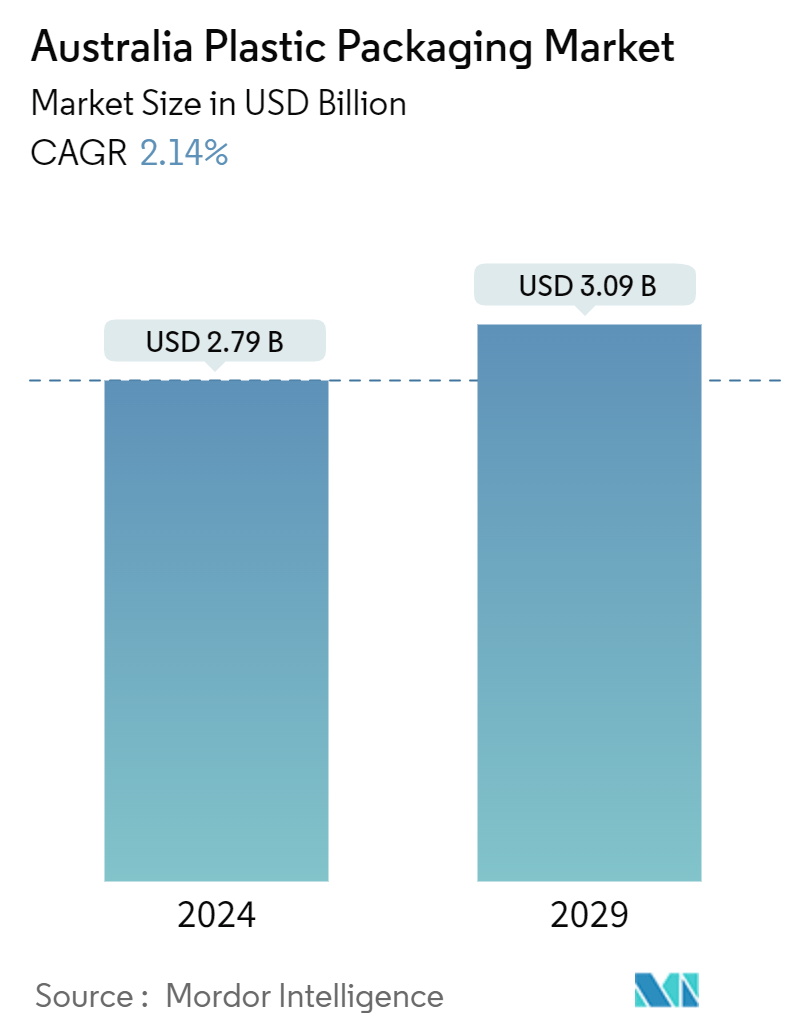
| Study Period | 2019 - 2029 |
| Base Year For Estimation | 2023 |
| Market Size (2024) | USD 2.79 Billion |
| Market Size (2029) | USD 3.09 Billion |
| CAGR (2024 - 2029) | 2.14 % |
| Market Concentration | Low |
Major Players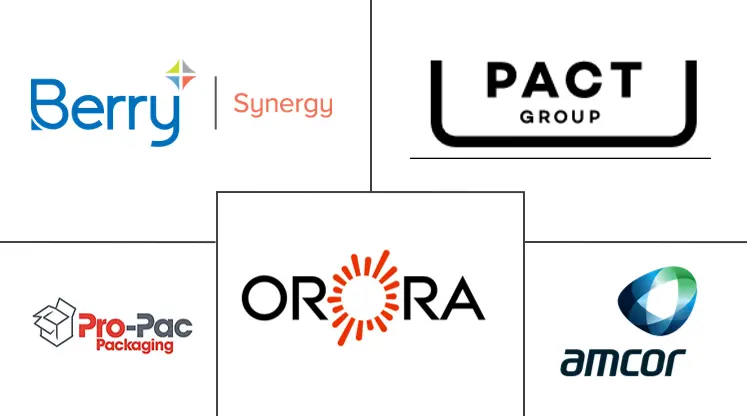
*Disclaimer: Major Players sorted in no particular order |
Australia Plastic Packaging Market Analysis
The Australia Plastic Packaging Market size is estimated at USD 2.79 billion in 2024, and is expected to reach USD 3.09 billion by 2029, growing at a CAGR of 2.14% during the forecast period (2024-2029).
The increasing demand for plastic packaging in Australia is attributable to the country's increasing food and beverage consumption. Increasing tourism, a busy consumer lifestyle, and a preference for convenient products have also enhanced the demand for plastic packaging.
- Australia witnessed a significant increase in population in the previous decade. It is anticipated to drive the demand for consumables, such as beverages, which include alcoholic and non-alcoholic liquids, packaged meals, and packaged drinking water, which prefer plastic packaging medium over other alternatives, owing to high portability enabled by the lightweight of the plastics.
- According to data from the United States Department of Agriculture (USDA), Australia's food, beverage, and grocery sectors dominate the manufacturing arena, accounting for a third of the nation's manufacturing activity. This sector comprises over 16,000 enterprises, including numerous solo traders and small to medium-sized enterprises (SMEs). The growth of the food processing industry is primarily fueled by price hikes, increasing domestic demand, and a surge in exports, all of which are catalysts for market expansion.
- The Australian plastic packaging market is witnessing a surge in product innovations, particularly in sustainable products. Key players such as Amcor Group GmbH and Pact Group are spearheading this movement, emphasizing innovative and eco-friendly packaging solutions. Notably, in January 2024, Amcor's commitment to sustainability was underscored when it was lauded as a sustainable packaging leader by the Dow Jones Sustainability Indices (DJSI) Australia.
- However, the growing environmental concerns toward plastic packaging waste in Australia is a major challenge for the market's growth. According to the Australia Institute, Australia is projected to more than double its plastic consumption by 2050. However, despite governmental efforts to foster a 'circular economy,' only 14% of plastic waste is diverted from landfills, impeding the demand for plastic packaging. As a result, manufacturers in the country are resorting to the use of plastic alternatives, including metal and paper, for packaging.
Australia Plastic Packaging Market Trends
The Rigid Packaging Segment is Expected to Register the Highest Growth
- Australia's robust appetite for plastic packaging, driven by its high plastic consumption, is a key driver of the market's growth. Data from Chemistry Australia, a governmental body, reveals the nation's annual plastic product consumption is around 3.5 million tonnes.
- Rigid packaging plays a pivotal role in product manufacturing and distribution. It primarily consists of robust materials like metals, glass, and specific plastics such as polyethylene, polypropylene, and PET. Its diverse applications safeguard products from food and beverages to electronics and cosmetics.
- The Australian food and beverage sector is rapidly expanding, fueled by rising tourism and evolving consumer tastes. The Australian Beverage Council highlights that packaged water, including spring, purified, and mineral variants, reigns as the leading non-dairy and non-alcoholic beverage in the country.
- Moreover, as Australian consumers increasingly seek healthy and convenient food options, the demand for convenience foods is on the rise, translating to a heightened use of plastics in packaging.
- The surging demand for polyethylene (PE) and polypropylene (PP) plastics in Australia, specifically for rigid packaging, is a significant growth driver. HDPE and LDPE are the predominant materials for caps and closures, with HDPE being prevalent in packaged water, dairy products, and juice bottles. In 2023, data from the Australian Packaging Covenant Organization (APCO) indicated that 35% of rigid packaging in Australia was composed of HDPE, followed by 25% of PP.
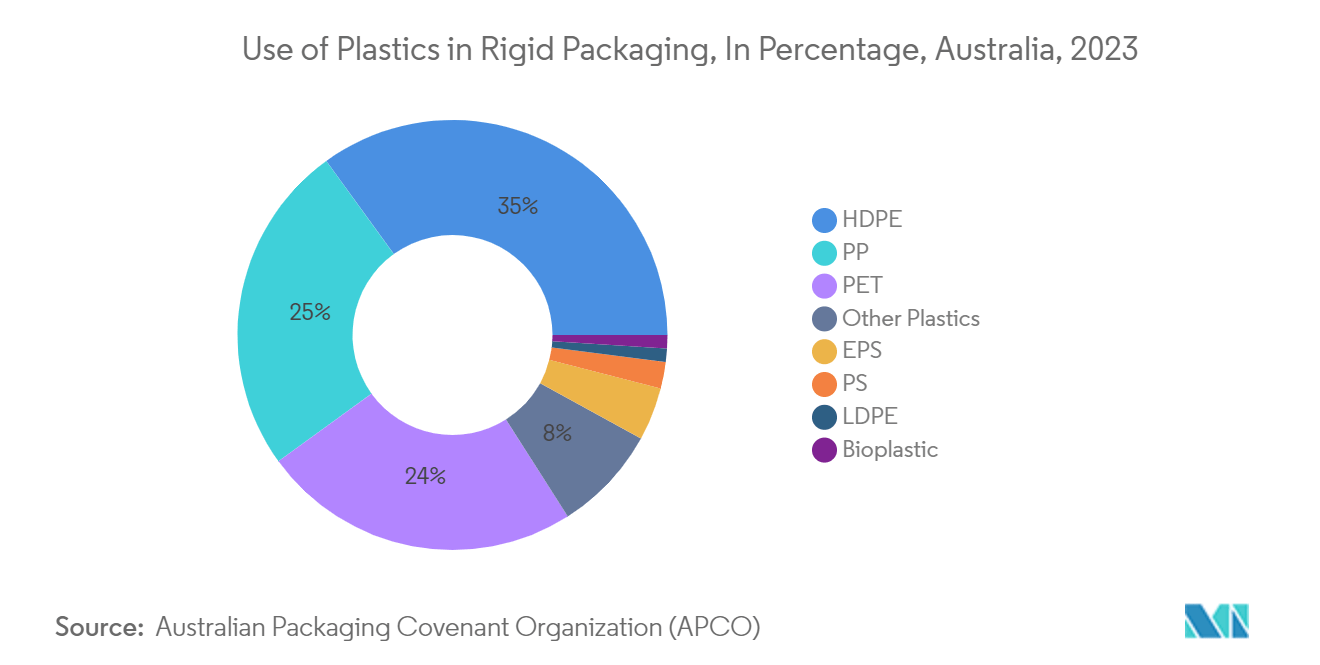
The Food Segment is Expected to Dominate the Market
- As of 2023, Australia was the 14th largest economy globally, as reported by the United States Department of Agriculture (USDA). It stands out with one of the world's highest per capita GDP levels and holds the second spot for median wealth per adult, according to UBS's 2023 Global Wealth Report.
- Australia's push toward sustainable food packaging is primarily fueled by a rising tourism sector and a domestic population increasingly seeking convenience in packaged food products. This surge in demand is notably boosting both rigid and flexible packaging needs in the nation. Australian consumers are showing a clear preference for environmentally conscious products and brands. Consequently, food producers and retailers are channeling significant investments into sustainable practices, further propelling the market's growth.
- Key players in the country, such as Orora Packaging Australia Pty Ltd, are at the forefront, offering innovative and sustainable packaging solutions. Their range includes boxes, bottles, and packaging films designed to elevate product protection across various industries. Moreover, Orora provides tailored customization options, helping their client's brands stand out on retail shelves.
- Backing this trend, the USDA highlights that Australia's expanding food processing sector is a direct response to the surging consumer appetite for novel food offerings. In 2023, the country imported food processing ingredients worth USD 13.2 billion, with New Zealand, the United States, and China emerging as its top three suppliers, significantly bolstering the local market.
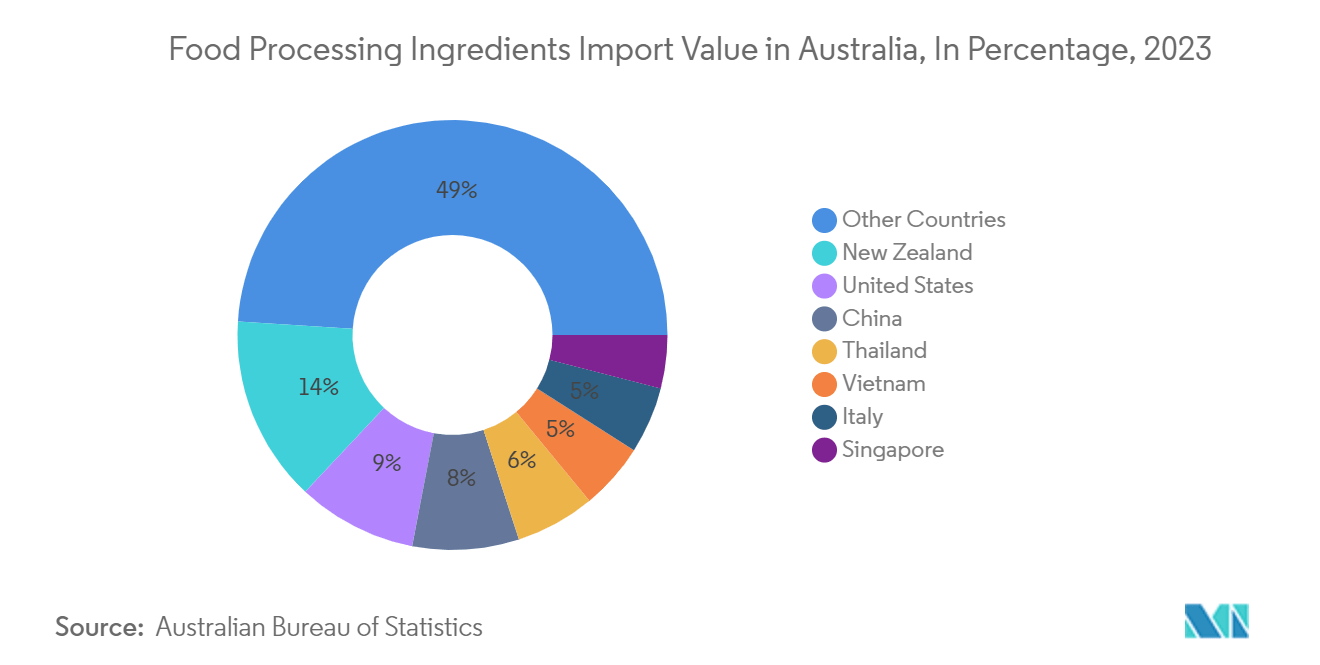
Australia Plastic Packaging Industry Overview
The Australian plastic packaging market exhibits significant fragmentation, with competitors vying to distinguish themselves by emphasizing recycled content and the recyclability of their plastic packages. Domestic vendors face stiff competition from international giants, who bolster their dominance through strategies such as mergers, acquisitions, and innovative product launches. Notable players in this landscape include Orora Packaging Australia Pty Ltd, Filton Packaging Pty Ltd, Flexible Packaging Solutions Pty Ltd, Amcor Group GmbH, and Econopak Flexible Packaging.
- April 2024: Amcor Group GmbH, a Switzerland-based company with operations in Australia, introduced a one-liter polyethylene terephthalate (PET) bottle specifically designed for carbonated soft drinks (CSDs). This innovative bottle is crafted from 100% post-consumer recycled (PCR) materials.
Australia Plastic Packaging Market Leaders
-
Pact Group Holdings Australia Pty Ltd .
-
Synergy Packaging (BERRY GLOBAL INC.)
-
Pro-Pac Packaging Pty Ltd .
-
Orora Packaging Australia Pty Ltd
-
Amcor Group GmbH
*Disclaimer: Major Players sorted in no particular order
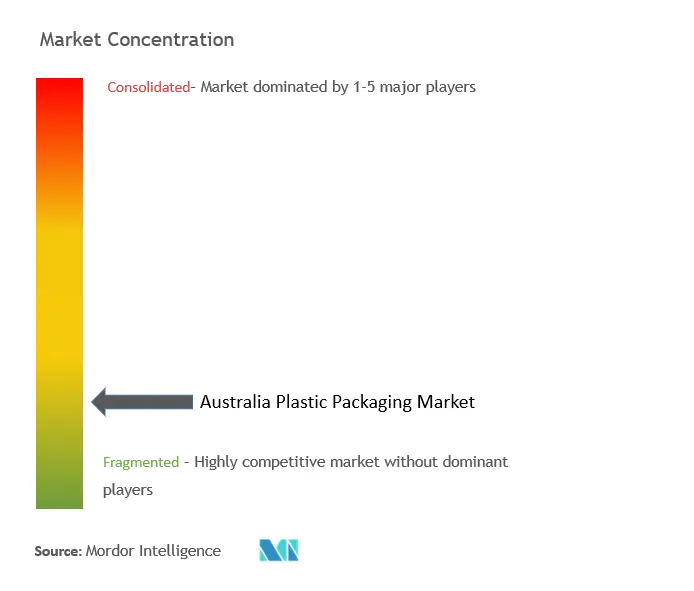
Australia Plastic Packaging Market News
- May 2024: PakTech, a US-based manufacturer of recycled and recyclable multipack packaging solutions, announced the launch of its local manufacturing operations in Australia. The company has entered the market by collaborating with the Endeavor Group, an Australian alcoholic drinks retailer.
- March 2024: Amcor Group GmbH, a Switzerland-based company with a significant presence in Australia, clinched eight awards at the 2024 Flexible Packaging Association (FPA) annual meeting in the United States.
Australia Plastic Packaging Market Report - Table of Contents
1. INTRODUCTION
- 1.1 Study Assumptions and Market Definition
- 1.2 Scope of the Study
2. RESEARCH METHODOLOGY
3. EXECUTIVE SUMMARY
4. MARKET INSIGHTS
- 4.1 Market Overview
- 4.2 Industry Value Chain Analysis
-
4.3 Industry Attractiveness - Porter's Five Forces Analysis
- 4.3.1 Threat of New Entrants
- 4.3.2 Bargaining Power of Consumers
- 4.3.3 Threat of New Entrants
- 4.3.4 Threat of Substitute Products
- 4.3.5 Intensity of Competitive Rivalry
5. MARKET DYNAMICS
-
5.1 Market Drivers
- 5.1.1 Increasing Demand for Packaging from the Food Industry
- 5.1.2 Rising Demand for Eco-Friendly and Sustainable Packaging
-
5.2 Market Challenges
- 5.2.1 Growing Environmental Concerns Regarding Plastic Packaging
6. INDUSTRY REGULATIONS, POLICIES, AND STANDARDS
7. MARKET SEGMENTATION
-
7.1 Rigid Packaging
- 7.1.1 Material
- 7.1.1.1 Polyethylene Terephthalate (PET)
- 7.1.1.2 Polypropylene (PP)
- 7.1.1.3 Polystyrene (PS) and Expanded Polystyrene (EPS)
- 7.1.1.4 Polyvinyl Chloride (PVC)
- 7.1.1.5 Polyethene (PE)
- 7.1.2 Product
- 7.1.2.1 Bottles and Jars
- 7.1.2.2 Trays and Containers
- 7.1.2.3 Other Product Types
-
7.2 Flexible Packaging
- 7.2.1 Material
- 7.2.1.1 Polyethene (PE)
- 7.2.1.2 Bi-orientated Polypropylene (BOPP)
- 7.2.1.3 Cast Polypropylene (CPP)
- 7.2.1.4 Polyvinyl Chloride (PVC)
- 7.2.1.5 Other Flexible Packaging Materials
- 7.2.2 Product
- 7.2.2.1 Pouches
- 7.2.2.2 Bags
- 7.2.2.3 Films and Wraps
- 7.2.2.4 Other Product Types
-
7.3 Industrial Plastic Film Market
- 7.3.1 Stretch Film
- 7.3.2 Agricultural Film
-
7.4 End-user Industry
- 7.4.1 Food
- 7.4.2 Beverage
- 7.4.3 Healthcare
- 7.4.4 Personal Care and Household
- 7.4.5 Other End-user Industries
8. COMPETITIVE LANDSCAPE
-
8.1 Company Profiles*
- 8.1.1 Orora Packaging Australia Pty Ltd
- 8.1.2 Filton Packaging Pty Ltd
- 8.1.3 Flexible Packaging Solutions Pty Ltd
- 8.1.4 Gravure Packaging Ltd
- 8.1.5 Econopak Flexible Packaging
- 8.1.6 Pro-Pac Packaging Pty Ltd
- 8.1.7 A&M Packaging Pty Ltd
- 8.1.8 Caspak Products Pty Ltd
- 8.1.9 Synergy Packaging (RPC Group)
- 8.1.10 Visy Industries Australia Pty Ltd
- 8.1.11 Pact Group Holdings Australia Pty Ltd
- 8.1.12 Cospak Pty Ltd
- 8.1.13 Vacupack Pty Ltd
- 8.1.14 Plasmo Pty Ltd
9. INVESTMENT ANALYSIS
10. MARKET OPPORTUNITIES AND FUTURE TRENDS
** Subject To AvailablityAustralia Plastic Packaging Industry Segmentation
Plastics are used in packaging materials for food, beverages, and oil. They are used mainly because of their performance, cost-effectiveness, and durability. Depending on the type of product being packed, plastics can be of different grades and material combinations, such as polyethylene, polypropylene, and polyvinyl chloride.
The Australian plastic packaging market is segmented by rigid packaging (material (polyethylene terephthalate (PET), polypropylene (PP), polystyrene (PS) and expanded polystyrene (EPS), polyvinyl chloride (PVC), and polyethene (PE)) and product (bottles and jars, trays and containers, and other product types)), flexible packaging (material (polyethene (PE), bi-orientated polypropylene (BOPP), cast polypropylene (CPP), polyvinyl chloride (PVC), and other flexible packaging materials) and product (pouches, bags, films and wraps, and other product types)), industrial plastic film market (stretch film and agricultural film), and end-user industry (food, beverage, healthcare, personal care and household, and other end-user industries). The market sizes and forecasts are in terms of value (USD) for all the above segments.
| Rigid Packaging | Material | Polyethylene Terephthalate (PET) |
| Polypropylene (PP) | ||
| Polystyrene (PS) and Expanded Polystyrene (EPS) | ||
| Polyvinyl Chloride (PVC) | ||
| Polyethene (PE) | ||
| Rigid Packaging | Product | Bottles and Jars |
| Trays and Containers | ||
| Other Product Types | ||
| Flexible Packaging | Material | Polyethene (PE) |
| Bi-orientated Polypropylene (BOPP) | ||
| Cast Polypropylene (CPP) | ||
| Polyvinyl Chloride (PVC) | ||
| Other Flexible Packaging Materials | ||
| Flexible Packaging | Product | Pouches |
| Bags | ||
| Films and Wraps | ||
| Other Product Types | ||
| Industrial Plastic Film Market | Stretch Film | |
| Agricultural Film | ||
| End-user Industry | Food | |
| Beverage | ||
| Healthcare | ||
| Personal Care and Household | ||
| Other End-user Industries |
Australia Plastic Packaging Market Research FAQs
How big is the Australia Plastic Packaging Market?
The Australia Plastic Packaging Market size is expected to reach USD 2.79 billion in 2024 and grow at a CAGR of 2.14% to reach USD 3.09 billion by 2029.
What is the current Australia Plastic Packaging Market size?
In 2024, the Australia Plastic Packaging Market size is expected to reach USD 2.79 billion.
Who are the key players in Australia Plastic Packaging Market?
Pact Group Holdings Australia Pty Ltd ., Synergy Packaging (BERRY GLOBAL INC.), Pro-Pac Packaging Pty Ltd ., Orora Packaging Australia Pty Ltd and Amcor Group GmbH are the major companies operating in the Australia Plastic Packaging Market.
What years does this Australia Plastic Packaging Market cover, and what was the market size in 2023?
In 2023, the Australia Plastic Packaging Market size was estimated at USD 2.73 billion. The report covers the Australia Plastic Packaging Market historical market size for years: 2019, 2020, 2021, 2022 and 2023. The report also forecasts the Australia Plastic Packaging Market size for years: 2024, 2025, 2026, 2027, 2028 and 2029.
Plastic Packaging in Australia Industry Report
Statistics for the 2024 Plastic Packaging in Australia market share, size and revenue growth rate, created by Mordor Intelligence™ Industry Reports. Plastic Packaging in Australia analysis includes a market forecast outlook to 2029 and historical overview. Get a sample of this industry analysis as a free report PDF download.



